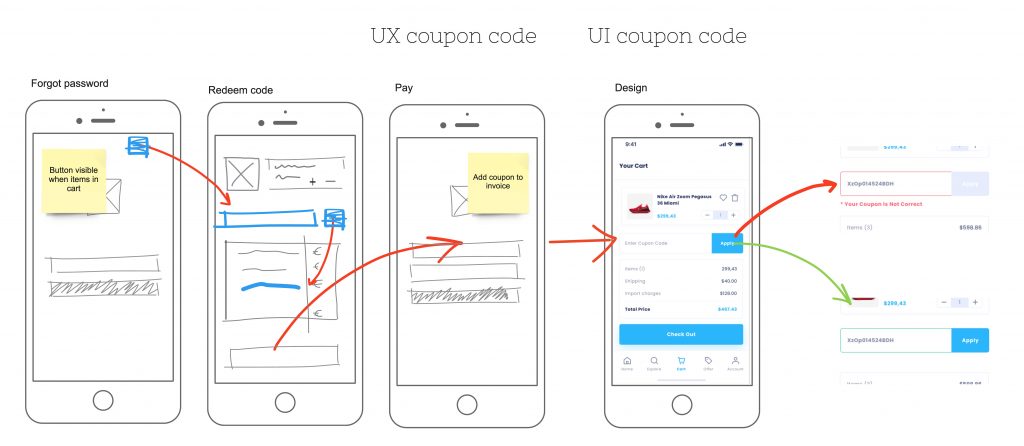Part 1 of this series was about how to get an idea worked out into artefacts. In part 2 I illustrated this flow a bit more with examples and created the artefacts. This part will be about translating these artefacts into user stories and acceptance criteria.

The result of our activities in part 1 and 2 are the following artefacts:
- Epic goal
- User flows
- UI and UX designs
- Data model
Epic Goal
We think that implementing a way to create and redeem coupon codes (What)
Will give an incentive to buy more often at our shop (Why)
To our new and existing users (Who)
We know we have succeeded when:
- 75% of all sent coupon codes are actually used in transactions
- 13% higher sales by customers who received a coupon vs customer who haven’t
- 5% increase of recurring customer sale
User flows
For this example we took the customer’s user flow. This person received a coupon code somehow and wants to redeem it during a transaction.

As a customer of the webshop,
I want to be able to redeem coupon codes,
So that I receive discounts.
Acceptance criteria
When looking at the user flow I can easily spot the user input actions and the actions made by the system and I can describe both their behaviour in the form of acceptance tests.

Happy path
First I describe the happy path:
Scenario: Redeem coupon code
Given I have items in my shopping card
And I have an order with the value of € 134,-
And coupon code 2345EX is a code for 30% discount
When I fill in 2345EX in the coupon field
Then the system shows me the code is valid
When I click on the Apply button
Then the total price in my cart is updated to € 93.80
And I see a discount displayed of € 40.20
When I click on the Checkout button
Then I see the Checkout screen
As you can imagine this is a small part of the total end to end tests but it covers our new addition to the product.
Unhappy path
I also see my first deviation from the happy path: an invalid coupon code. I write another scenario.
Scenario: Try an invalid coupon code
Given I have items in my shopping card
And I have an order with the value of € 134,-
And coupon code 2345EX is a code for 30% discount
When I fill in INVALID-CODE in the coupon field
Then the system shows me the code is invalid
And the Apply button is disabled
When I fill in 2345EX in the coupon field
Then the system shows me the code is valid
And the Apply button is enabled
When I click on the Apply button
Then the total price in my cart is updated to € 93.80
And I see a discount displayed of € 40.20
When I click on the Checkout button
Then I see the Checkout screen
Edge cases
I also see an edge case that would be worthwhile to describe: what happens when we go back from the updated prices to the first screen and do everything over again? My experience tells me to expect the unexpected always.
UX/UI
I will make sure now that I update my UI right away. I did not include the following in my original design:
- The system shows me the code is valid
- The system shows me the code is invalid
- The Apply button is enabled
- The Apply button is disabled
In this case they are not quite revolutionary designs but I decide to show them anyway because I am rather safe than sorry:

Validate
We defined successfactors while describing the epic goal. We often tend to forget about them but we have to consider them with each story. We said that we know we have succeeded when:
- 75% of all sent coupon codes are actually used in transactions
- 13% higher sales by customers who received a coupon vs customer who haven’t
- 5% increase of recurring customer sale
We have thought about the connection Customer – Coupon code – Order in the data model and coupon codes have a status.
For this story I would add a task that we change the status for the personal coupon code to ‘Redeemed’ after checkout. For a non-personal I would like to increase the redeemed coupon count with 1. We now can be sure we can find all the success factors in our database and we can see if we are reaching our goal.

And now we are done!
Our first story is done. We have many more to write. In part 2 we found some more that are related to this one. We can now present it to the team and discuss possibilities and ways to implement. I am pretty confident that I thought of many things. I am also pretty sure that I might have missed things and that changes might be needed. And that is perfectly okay! That is an important part of Product Ownership.
